Squatting inside a 10-feet deep ditch, Chutki Bisra of Teesro village is busy scraping the ground. It is late afternoon and the Santhal tribe woman’s small cane basket is barely half-full with mica scrap, locally known as dhibra. “I earn Rs 5 per kilo of dhibra. I should at least collect one basket [fetches her Rs 20-30 a day] to feed my family,” she told Gaon Connection.
Teesro village in Tisri block of Giridih is a settlement of Santhal tribe, one of the 32 schedule tribes in Jharkhand. The state has a tribal population of 26.2 per cent. All the families, including children, in Teesro village, depend on collection and sale of dhibra — mica mineral, a natural insulator used in car and building sectors, electronics and cosmetics — to make a living.
“There is no employment opportunity here. Farming is subsistence. We eat mahua [Mahua longifolia] and sell dhibra. Our grandfathers also used to do the same,” said Totarai, a resident of Teesro.
Giridih district, one of the richest mica resource regions in the country, is not the only natural resource-rich zone in Jharkhand. The state holds the number one position in coal resources (27 per cent) in India and is the sole producer of non-coking coal.
Pashchimi Singhbhum district alone contributes 29 per cent of the total iron deposits in the country. Other important minerals found in the state include bauxite, limestone, manganese, graphite, kyanite, copper, which are available in huge quantities.
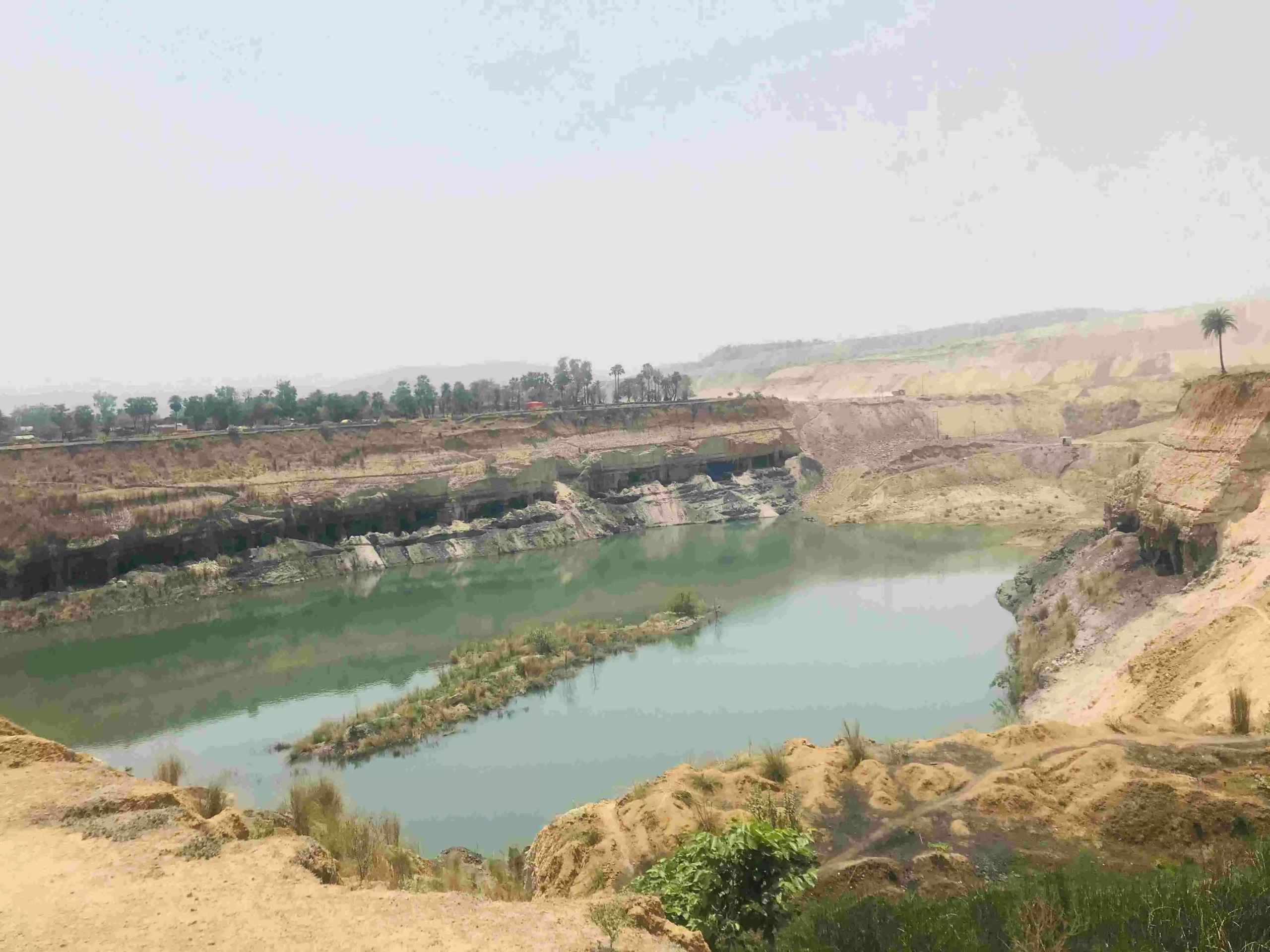
An abandoned coal mine in Godda, Jharkhand. Pic: Nidhi Jamwal
No wonder the state has the second-highest collection under the mining fund — officially known as the District Mineral Foundation, or DMF.
As of September 30 this year, of the total Rs 32,550.80 crore mining fund collected by all the 21 mining states in the country, Rs 4,717.56 crore is Jharkhand’s DMF, as documented on the website of Union ministry of mines.
But, more than half of the collected fund is unutilised in the state. And, the majority of the fund has been channelised to build toilets under the Swachh Bharat Mission. As the state goes to polls, this is a question that must be raised in the Jharkhand Assembly elections.
“Our analysis shows that critical issues like malnutrition, livelihood and income security, crippling all mining areas, including those in Jharkhand, have peanut amount sanctioned under DMF. A big focus everywhere has been on physical infrastructure development, including construction of major roads,” Srestha Banerjee, programme manager with environmental governance unit of Centre for Science and Environment (CSE) told Gaon Connection. Last year, CSE, a research and advocacy organisation based in New Delhi, analysed DMF in 50 top mining districts across 12 states in the country.
“Three years ago, the Jharkhand government issued a blanket direction to spend DMF money on drinking water [mainly piped water supply] and sanitation projects to meet the ODF [open defecation free] target under the Swachh Bharat Mission. And, districts sanctioned funds to this effect for the next three years, that is till 2019,” said Banerjee.
Thus, there was no scope of need-based planning under DMF, as the law envisions. For instance, in Pashchimi Singhbhum district of the state, the under-five mortality rate is 96 (national average is 50 and Jharkhand state average is 54) and at least 50 per cent children below five years of age are malnourished. “But, the district has failed to make required investments in child health and nutrition despite a sizeable DMF corpus,” she added.
Clearly, a fund meant to benefit the mining-affected communities in the state has either remained unspent, or spent without need-based planning. But, this is not what the fund was envisioned for when it was set up in 2015.
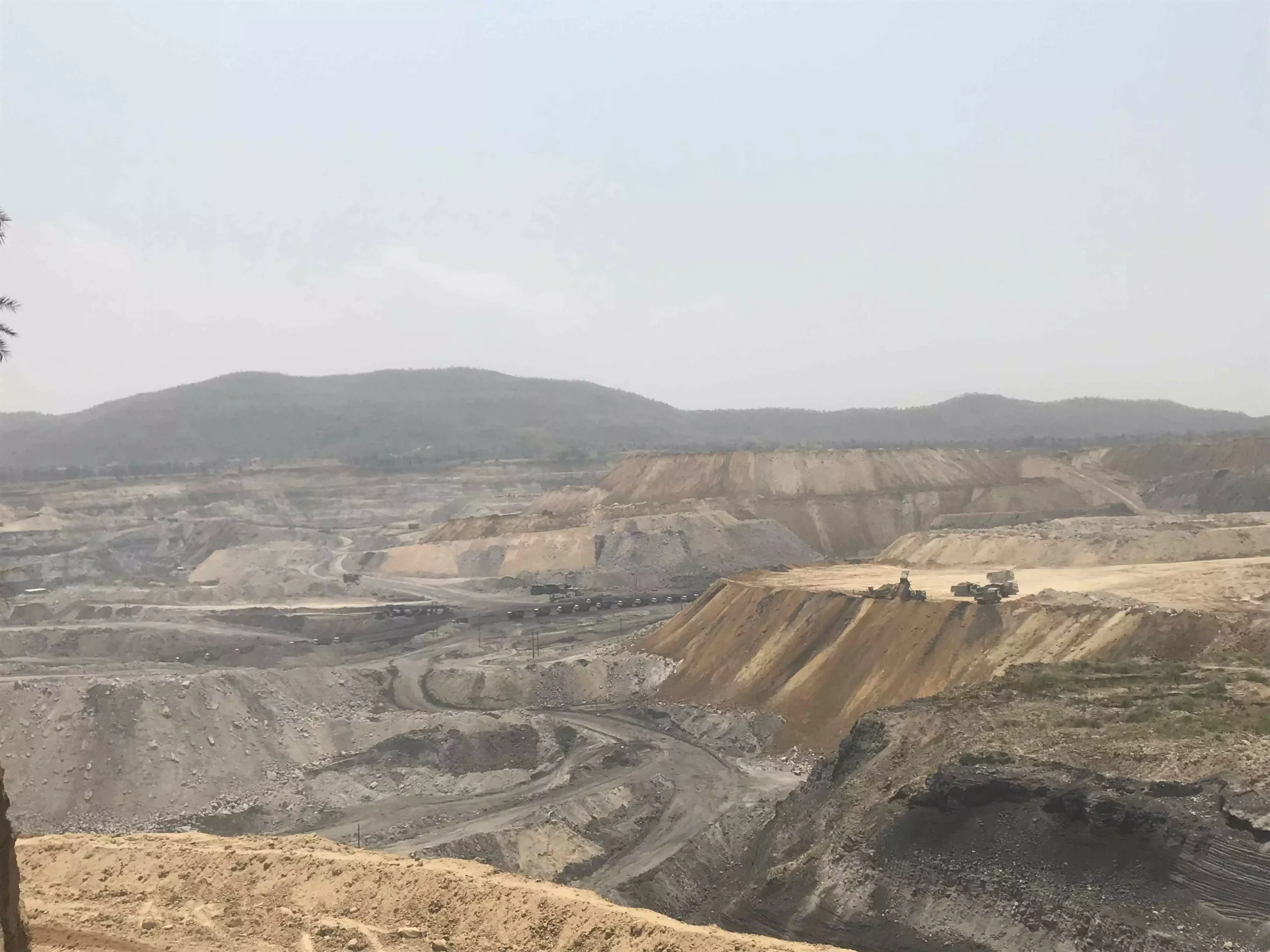
Jharkhand has the second highest mining fund in the country, more than half of which remains unspent. Pic: Nidhi Jamwal
Why DMF?
In March 2015, District Mineral Foundation (DMF) was instituted through an amendment in India’s central mining law — the Mines and Minerals (Development and Regulation) Act, 1957. The precise objective of this fund was to ‘work for the interest and benefit of persons, and areas affected by mining-related operations’.
This fund was conceptualised more than a decade ago to address the ironic inequality of India’s mining districts, where the richest lands are inhabited by some of the country’s poorest and most deprived, reads the CSE’s report, ‘People First: District Mineral Foundation Status Report 2018’. DMF came into effect to remove such inequality and ensure socio-economic and environmental justice for these people whose lands are resource-rich, but locals do not benefit from them.
The March 2015 amendment required DMF to be developed as a ‘Trust’. These non-profit trusts had to be set up in every mining district of the country. There is a mandated funding mechanism for these trusts from the miners/mining companies — 30 per cent equivalent of the royalty amount for leases granted before 2015, and 10 per cent for leases granted after that. The money thus collected under DMF has to be spent for benefit of the local mining-affected communities.
DMF Trusts have been set up in all the 557 mining districts spread across 21 states in the country. The Government of Jharkhand developed the Jharkhand DMF (Trust) Rules in 2016, to specifically guide the functioning of DMF Trusts in the state and to ensure the benefit of mining-affected communities and areas.
Money collected, but largely unspent
As of September 30 this year, Rs 32550.80 crore has been collected as DMF by all the 21 mining states in the country. More than 42 per cent of this fund has come from the coal and lignite sector.
A total of 135,472 projects have been sanctioned under the DMF in all these mining states of which only 39 per cent are complete.
In terms of money spent, of the Rs 27183.37 crore allocated for these 135,742 projects, only 37 per cent has been spent (see map: Money spent under DMF in key mining states till September 30, 2019).
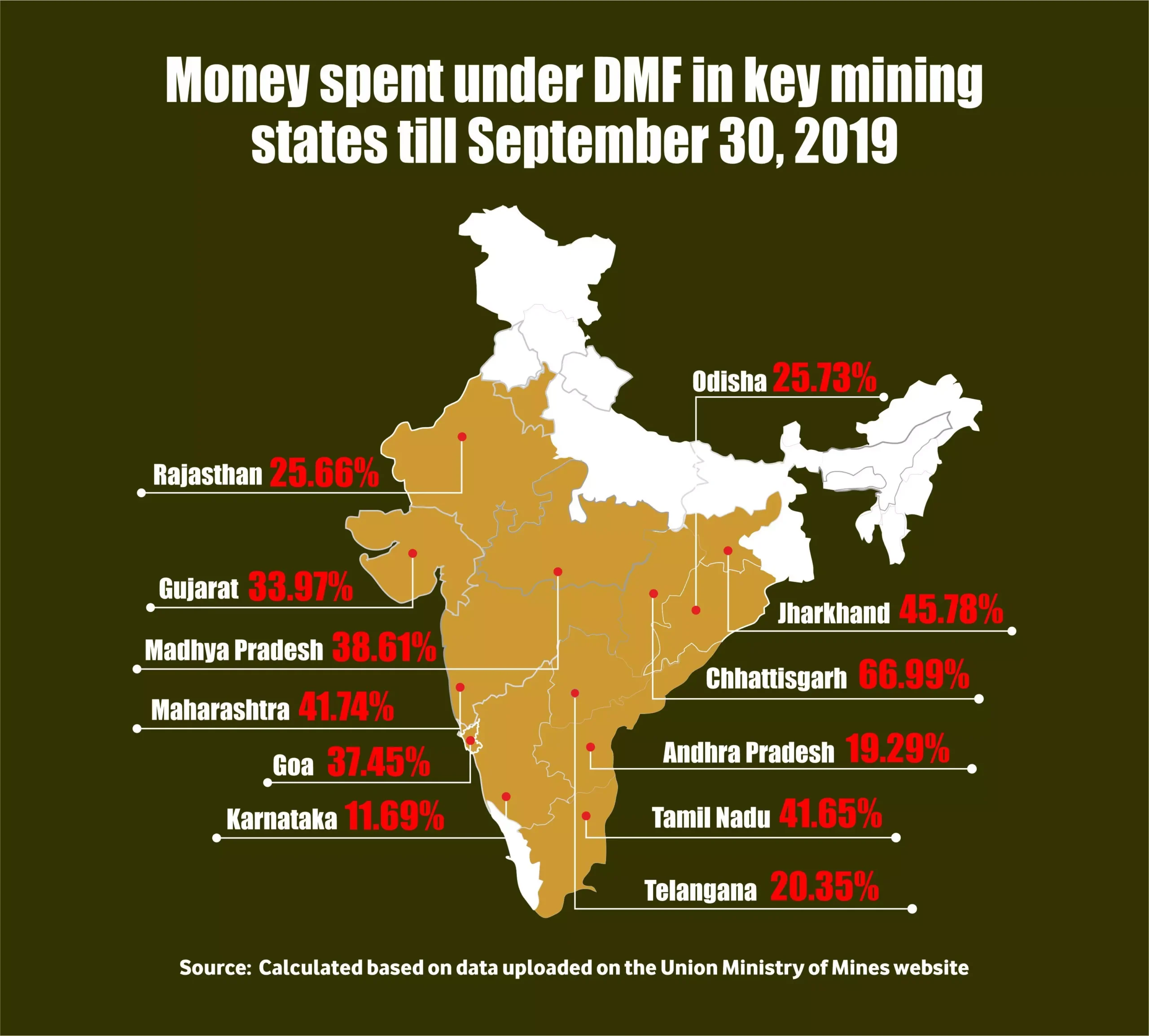
In case of Jharkhand, the state has collected Rs 4717.56 crore under DMF (till September 30 this year). About 75 per cent of the total DMF accrual is from coal mining in the state.
Of the total Rs 4717.56 crore collected, Rs 4322.11 crore was sanctioned for 16,895 projects in its 24 mining districts. But, the money spent is Rs 1979.08 crore, or 45.78 per cent only. Thus, almost 55 per cent funds sanctioned under DMF have remained unutilised in the state (see graph: State-wise DMF collected, amount allocated and money spent till September 30, 2019).
A large proportion of the spent money accounts for toilet construction, which is more targeted towards saturation of a Central Government scheme, as opposed to addressing the needs of mining-affected people, said Banerjee. This when the state has been besieged with issues of malnutrition, repeated droughts, pollution of water sources, poor implementation of the Forest Rights Act, 2006, and hunger deaths.
“The District Mineral Foundation is an opportunity created with humongous financial resources to address specific problems faced at the district level by the mining-affected people. These funds generated at the district level must only be put to use for the benefit of the ‘affected population’ in the district itself,” said Eklavya Prasad, managing trustee of Megh Pyne Abhiyan, a public charitable trust working on mining-affected areas of Jharkhand.
Graph: State-wise DMF collected, amount allocated and money spent till September 30, 2019
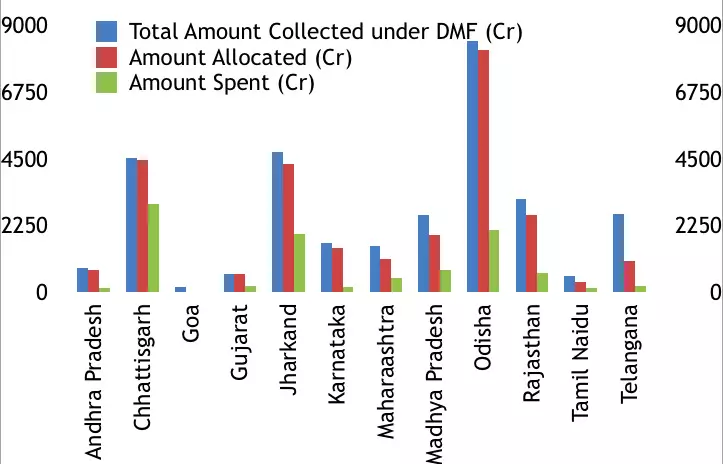
Source: Calculated based on data uploaded on the Union Ministry of Mines website
Piped water schemes, toilets and even a flyover
Dhanbad district has the highest money collected under DMF at Rs 1,178 crore followed by Pashchimi Singhbhum at Rs 940 crore. Other top DMF districts include Chatra (over Rs 631 crore), Ramgarh (over Rs 613 crore), Bokaro (over Rs 426 crore), Godda (over Rs 301 crore) and Hazaribagh (over Rs 201 crore).
A recent analysis on Jharkhand’s District Mineral Foundation Trust, prepared by CSE, shows that “majority of the sanctions have been for drinking waterworks (major piped water supply projects from river Damodar and its tributaries) and sanitation work (toilet construction related to ODF target).”
For instance, of the total 16,895 projects sanctioned in the state under DMF till September 30 this year, almost 94 per cent are drinking water (piped water supply) projects, which have received 77 per cent of the total DMF money sanctioned.
The second highest money allocation — Rs 493.6 crore — is for the sanitation (ODF) sector.
As against drinking water projects, where only 44 per cent of the allocated money has been spent, in the case of sanitation, money utilisation is 85 per cent.
Health has received 0.5 per cent of the total DMF money collected, and of that, only 40 per cent has been spent so far.
CSE’s recent analysis also shows the DMFT is still functioning in an ad hoc manner in most districts and the most pressing issues, such as child mortality, malnutrition and livelihood, have been neglected in the state while “money has been sanctioned for major town projects like flyovers. In Dhanbad, a Rs 256 crore flyover has been sanctioned through DMFT earlier this year.”
Mining is flourishing in several districts of the state, as reflected in the maps prepared by Pradeep Koulgi, an independent researcher and wildlife biologist based in Bengaluru. These are based on the Google Earth Engine Timelapse (see map: Spread of coal mining in Godda district from 2000 to 2018). But, the state has not taken any concrete efforts to identify the mining-affected people because of which many displaced (and resettled) people, or those who lost their livelihoods due to mining, have failed to benefit from the DMF.
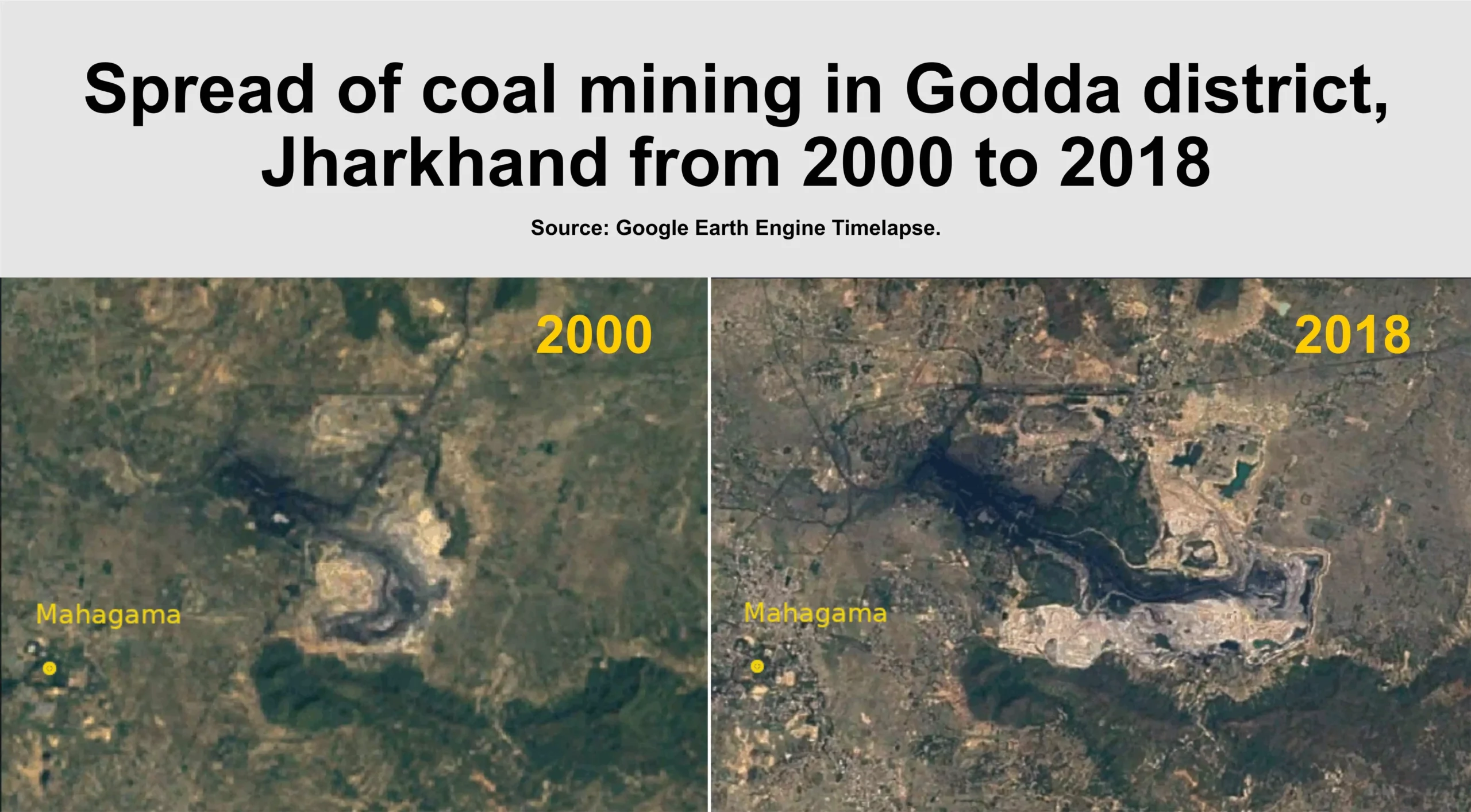
Source: Prepared by Pradeep Koulgi based on Google Earth Engine Timelapse
“In Dhanbad district, Baliapur block has been identified as a mining-affected region, and there are indications of the presence of fluoride in the groundwater of approximately 14 panchayats of this block, of which six panchayats are going to be supplied surface water from River Damodar in the first phase, whereas, the remaining eight are to be covered in the second phase,” said Prasad. “The people in these 14 panchayats are either waiting for the first phase of drinking water to be functional and the second phase to be commissioned. On the other hand, Dhanbad town has got Rs 256 crore flyover, Rs 4 crore for LED street lighting and another Rs 5 crore town hall renovation,” he added.
According to Banerjee, DMF is a unique opportunity to benefit the mining-affected communities and ensure inclusive development. But, in no mining district, this is being implemented. “Neither the mining-affected people have been identified, nor they are a part of the decision-making process. The decision-making is extremely top-down, with DMF bodies dominated by bureaucrats, local MLAs and MPs. This despite the powers accorded to gram sabha under the DMF law,” she said.
If mining-affected people have to benefit from the DMF, the present top-down functioning of the DMF trusts must change. Rather then being a bureaucratic task, it must turn into a people-oriented initiative.




















